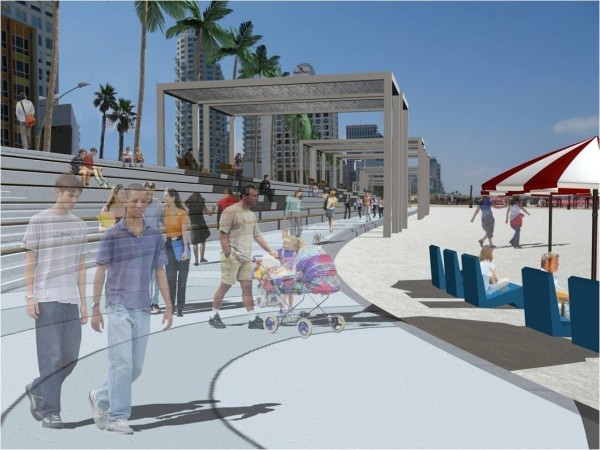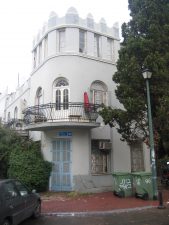A rendering of Tel Aviv’s new central promenade: stairs leading down to the beach, a paved lower level, shade-providing structures and new sidewalk and beach furniture. (image courtesy of Tel Aviv Municipality)
Two years ago, Tel Aviv presented a plan to redesign its central promenade. The plan – vague, unclear and buried inside another policy proposal – drew plenty of opposition from the public.
Last week, however, an improved version of the plan was presented at a public hearing. Over 100 residents showed up, all eager to make their voices heard. City officials listened to their concerns, and promised to take them into consideration as they draw up the plan’s final version. But neither the process nor the plan itself could please everyone.
Municipal officials and a handful of city council members also attended the meeting, which began with a short presentation by municipal planner Orly Harel, followed by a presentation by Udi Kassif, the architect charged with designing the new boardwalk.
Kassif, of Mayslits Kassif Architects (which was also commissioned to redesign Tel Aviv’s old port), was charged with designing the section of the beach between the Dolphinarium in the south and Gordon Pool in the north. The goal, he said, was to fuse the beach, the boardwalk and the adjacent Herbert Samuel street into a single public space, while connecting the beach to the city.
Among the problems with the current boardwalk, according to the architect, are the many obstacles (including scattered palm trees and benches) to pedestrian traffic, the old fashioned paving stones and street furniture, the wall that exists between the boardwalk and the beach, the haphazard storage spaces along this wall and a large, “unused” strip of sand between the boardwalk and the beach’s main bathing areas.
In order to improve the situation, he proposed removing those obstacles, new paving stones, stairs leading down to the sand instead of the wall that currently exists, new street furniture and shade-providing structures and a paved pedestrian area at the bottom of the stairs that would cover several meters of sand. He also proposed paved handicapped paths to the sea, as well as moving seaside restaurants closer to the boardwalk and away from the beach.
The hundred or so residents in attendance began by listening patiently to the presentation, but soon began losing their patience. The text of Kassif’s presentation, displayed in a small and dense font, was impossible for most to read. A related plan to narrow the adjacent Herbert Samuel Street was not presented at all. And many were outraged at the architects’ claim that parts of the beach were underutilized and could be paved over without inconveniencing anyone.
However, residents were very pleased to hear that the promenade would include a new bike lane (this, in fact, was the only part of the presentation which drew the crowd’s applause).
After the presentations, the audience was divided into small discussion groups, in which everyone was encouraged to contribute their thoughts and ideas, which were duly recorded. City officials promised that some of these suggestions would be integrated into the final designs.
Ira Rozen, a recent graduate of an urban planning program at Tel Aviv University, was disappointed with the event. “The presentation was poor,” he said. “The hall was large and the screen was small and difficult for the crowd to read, even from the front rows.”
Rozen, who wrote his master’s thesis on the privatization of planning in Israel, said the event was typical of participatory planning exercises in Tel Aviv, in which public input is only welcome at the end of the design process.
“It was like: ‘This is what we are going to do, now tell us what you think’,” said Rosen. ” It was clear to everyone that the municipality is not obligated to take anyone’s comments into account, and I think that because of that a lot of people related to the event as a chance to let off steam.”




